Shitao Xiao
MMTEB: Massive Multilingual Text Embedding Benchmark
Feb 19, 2025Abstract:Text embeddings are typically evaluated on a limited set of tasks, which are constrained by language, domain, and task diversity. To address these limitations and provide a more comprehensive evaluation, we introduce the Massive Multilingual Text Embedding Benchmark (MMTEB) - a large-scale, community-driven expansion of MTEB, covering over 500 quality-controlled evaluation tasks across 250+ languages. MMTEB includes a diverse set of challenging, novel tasks such as instruction following, long-document retrieval, and code retrieval, representing the largest multilingual collection of evaluation tasks for embedding models to date. Using this collection, we develop several highly multilingual benchmarks, which we use to evaluate a representative set of models. We find that while large language models (LLMs) with billions of parameters can achieve state-of-the-art performance on certain language subsets and task categories, the best-performing publicly available model is multilingual-e5-large-instruct with only 560 million parameters. To facilitate accessibility and reduce computational cost, we introduce a novel downsampling method based on inter-task correlation, ensuring a diverse selection while preserving relative model rankings. Furthermore, we optimize tasks such as retrieval by sampling hard negatives, creating smaller but effective splits. These optimizations allow us to introduce benchmarks that drastically reduce computational demands. For instance, our newly introduced zero-shot English benchmark maintains a ranking order similar to the full-scale version but at a fraction of the computational cost.
EfficientLLM: Scalable Pruning-Aware Pretraining for Architecture-Agnostic Edge Language Models
Feb 10, 2025Abstract:Modern large language models (LLMs) driven by scaling laws, achieve intelligence emergency in large model sizes. Recently, the increasing concerns about cloud costs, latency, and privacy make it an urgent requirement to develop compact edge language models. Distinguished from direct pretraining that bounded by the scaling law, this work proposes the pruning-aware pretraining, focusing on retaining performance of much larger optimized models. It features following characteristics: 1) Data-scalable: we introduce minimal parameter groups in LLM and continuously optimize structural pruning, extending post-training pruning methods like LLM-Pruner and SparseGPT into the pretraining phase. 2) Architecture-agnostic: the LLM architecture is auto-designed using saliency-driven pruning, which is the first time to exceed SoTA human-designed LLMs in modern pretraining. We reveal that it achieves top-quality edge language models, termed EfficientLLM, by scaling up LLM compression and extending its boundary. EfficientLLM significantly outperforms SoTA baselines with $100M \sim 1B$ parameters, such as MobileLLM, SmolLM, Qwen2.5-0.5B, OLMo-1B, Llama3.2-1B in common sense benchmarks. As the first attempt, EfficientLLM bridges the performance gap between traditional LLM compression and direct pretraining methods, and we will fully open source at https://github.com/Xingrun-Xing2/EfficientLLM.
Matryoshka Re-Ranker: A Flexible Re-Ranking Architecture With Configurable Depth and Width
Jan 27, 2025Abstract:Large language models (LLMs) provide powerful foundations to perform fine-grained text re-ranking. However, they are often prohibitive in reality due to constraints on computation bandwidth. In this work, we propose a \textbf{flexible} architecture called \textbf{Matroyshka Re-Ranker}, which is designed to facilitate \textbf{runtime customization} of model layers and sequence lengths at each layer based on users' configurations. Consequently, the LLM-based re-rankers can be made applicable across various real-world situations. The increased flexibility may come at the cost of precision loss. To address this problem, we introduce a suite of techniques to optimize the performance. First, we propose \textbf{cascaded self-distillation}, where each sub-architecture learns to preserve a precise re-ranking performance from its super components, whose predictions can be exploited as smooth and informative teacher signals. Second, we design a \textbf{factorized compensation mechanism}, where two collaborative Low-Rank Adaptation modules, vertical and horizontal, are jointly employed to compensate for the precision loss resulted from arbitrary combinations of layer and sequence compression. We perform comprehensive experiments based on the passage and document retrieval datasets from MSMARCO, along with all public datasets from BEIR benchmark. In our experiments, Matryoshka Re-Ranker substantially outperforms the existing methods, while effectively preserving its superior performance across various forms of compression and different application scenarios.
MegaPairs: Massive Data Synthesis For Universal Multimodal Retrieval
Dec 19, 2024Abstract:Despite the rapidly growing demand for multimodal retrieval, progress in this field remains severely constrained by a lack of training data. In this paper, we introduce MegaPairs, a novel data synthesis method that leverages vision language models (VLMs) and open-domain images, together with a massive synthetic dataset generated from this method. Our empirical analysis shows that MegaPairs generates high-quality data, enabling the multimodal retriever to significantly outperform the baseline model trained on 70$\times$ more data from existing datasets. Moreover, since MegaPairs solely relies on general image corpora and open-source VLMs, it can be easily scaled up, enabling continuous improvements in retrieval performance. In this stage, we produced more than 26 million training instances and trained several models of varying sizes using this data. These new models achieve state-of-the-art zero-shot performance across 4 popular composed image retrieval (CIR) benchmarks and the highest overall performance on the 36 datasets provided by MMEB. They also demonstrate notable performance improvements with additional downstream fine-tuning. Our produced dataset, well-trained models, and data synthesis pipeline will be made publicly available to facilitate the future development of this field.
AIR-Bench: Automated Heterogeneous Information Retrieval Benchmark
Dec 17, 2024



Abstract:Evaluation plays a crucial role in the advancement of information retrieval (IR) models. However, current benchmarks, which are based on predefined domains and human-labeled data, face limitations in addressing evaluation needs for emerging domains both cost-effectively and efficiently. To address this challenge, we propose the Automated Heterogeneous Information Retrieval Benchmark (AIR-Bench). AIR-Bench is distinguished by three key features: 1) Automated. The testing data in AIR-Bench is automatically generated by large language models (LLMs) without human intervention. 2) Heterogeneous. The testing data in AIR-Bench is generated with respect to diverse tasks, domains and languages. 3) Dynamic. The domains and languages covered by AIR-Bench are constantly augmented to provide an increasingly comprehensive evaluation benchmark for community developers. We develop a reliable and robust data generation pipeline to automatically create diverse and high-quality evaluation datasets based on real-world corpora. Our findings demonstrate that the generated testing data in AIR-Bench aligns well with human-labeled testing data, making AIR-Bench a dependable benchmark for evaluating IR models. The resources in AIR-Bench are publicly available at https://github.com/AIR-Bench/AIR-Bench.
OmniGen: Unified Image Generation
Sep 17, 2024


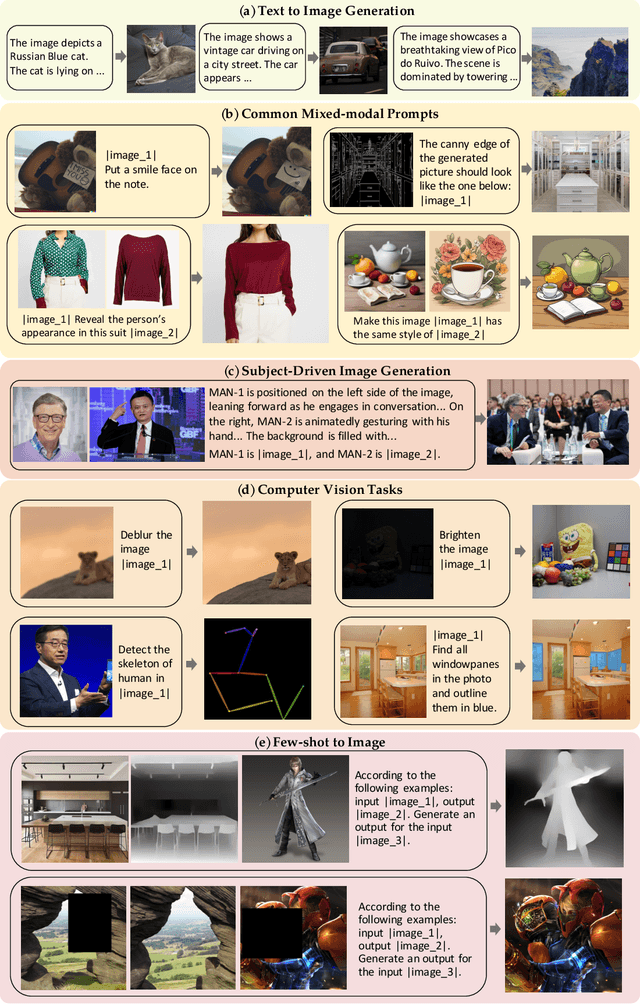
Abstract:In this work, we introduce OmniGen, a new diffusion model for unified image generation. Unlike popular diffusion models (e.g., Stable Diffusion), OmniGen no longer requires additional modules such as ControlNet or IP-Adapter to process diverse control conditions. OmniGenis characterized by the following features: 1) Unification: OmniGen not only demonstrates text-to-image generation capabilities but also inherently supports other downstream tasks, such as image editing, subject-driven generation, and visual-conditional generation. Additionally, OmniGen can handle classical computer vision tasks by transforming them into image generation tasks, such as edge detection and human pose recognition. 2) Simplicity: The architecture of OmniGen is highly simplified, eliminating the need for additional text encoders. Moreover, it is more user-friendly compared to existing diffusion models, enabling complex tasks to be accomplished through instructions without the need for extra preprocessing steps (e.g., human pose estimation), thereby significantly simplifying the workflow of image generation. 3) Knowledge Transfer: Through learning in a unified format, OmniGen effectively transfers knowledge across different tasks, manages unseen tasks and domains, and exhibits novel capabilities. We also explore the model's reasoning capabilities and potential applications of chain-of-thought mechanism. This work represents the first attempt at a general-purpose image generation model, and there remain several unresolved issues. We will open-source the related resources at https://github.com/VectorSpaceLab/OmniGen to foster advancements in this field.
Large Language Models as Foundations for Next-Gen Dense Retrieval: A Comprehensive Empirical Assessment
Aug 23, 2024



Abstract:Pretrained language models like BERT and T5 serve as crucial backbone encoders for dense retrieval. However, these models often exhibit limited generalization capabilities and face challenges in improving in domain accuracy. Recent research has explored using large language models (LLMs) as retrievers, achieving SOTA performance across various tasks. Despite these advancements, the specific benefits of LLMs over traditional retrievers and the impact of different LLM configurations, such as parameter sizes, pretraining duration, and alignment processes on retrieval tasks remain unclear. In this work, we conduct a comprehensive empirical study on a wide range of retrieval tasks, including in domain accuracy, data efficiency, zero shot generalization, lengthy retrieval, instruction based retrieval, and multi task learning. We evaluate over 15 different backbone LLMs and non LLMs. Our findings reveal that larger models and extensive pretraining consistently enhance in domain accuracy and data efficiency. Additionally, larger models demonstrate significant potential in zero shot generalization, lengthy retrieval, instruction based retrieval, and multi task learning. These results underscore the advantages of LLMs as versatile and effective backbone encoders in dense retrieval, providing valuable insights for future research and development in this field.
SpikeLLM: Scaling up Spiking Neural Network to Large Language Models via Saliency-based Spiking
Jul 05, 2024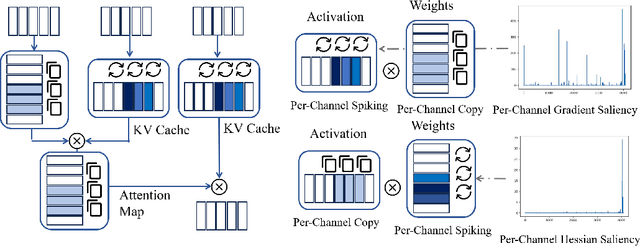
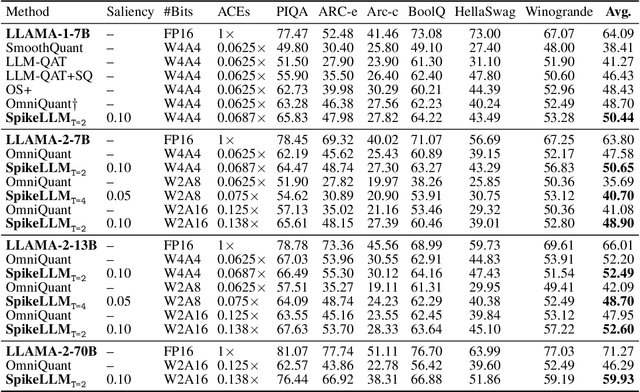

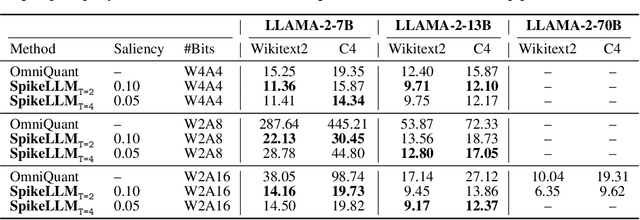
Abstract:The recent advancements in large language models (LLMs) with billions of parameters have significantly boosted their performance across various real-world applications. However, the inference processes for these models require substantial energy and computational resources, presenting considerable deployment challenges. In contrast, human brains, which contain approximately 86 billion biological neurons, exhibit significantly greater energy efficiency compared to LLMs with a similar number of parameters. Inspired by this, we redesign 7 to 70 billion parameter LLMs using bio-plausible spiking mechanisms, emulating the efficient behavior of the human brain. We propose the first spiking large language model as recent LLMs termed SpikeLLM. Coupled with the proposed model, a novel spike-driven quantization framework named Optimal Brain Spiking is introduced to reduce the energy cost and accelerate inference speed via two essential approaches: first (second)-order differentiation-based salient channel detection, and per-channel salient outlier expansion with Generalized Integrate-and-Fire neurons. Our proposed spike-driven quantization can plug in main streams of quantization training methods. In the OmniQuant pipeline, SpikeLLM significantly reduces 25.51% WikiText2 perplexity and improves 3.08% average accuracy of 6 zero-shot datasets on a LLAMA2-7B 4A4W model. In the GPTQ pipeline, SpikeLLM realizes a sparse ternary quantization, which achieves additive in all linear layers. Compared with PB-LLM with similar operations, SpikeLLM also exceeds significantly. We will release our code on GitHub.
MLVU: A Comprehensive Benchmark for Multi-Task Long Video Understanding
Jun 06, 2024



Abstract:The evaluation of Long Video Understanding (LVU) performance poses an important but challenging research problem. Despite previous efforts, the existing video understanding benchmarks are severely constrained by several issues, especially the insufficient lengths of videos, a lack of diversity in video types and evaluation tasks, and the inappropriateness for evaluating LVU performances. To address the above problems, we propose a new benchmark, called MLVU (Multi-task Long Video Understanding Benchmark), for the comprehensive and in-depth evaluation of LVU. MLVU presents the following critical values: 1) The substantial and flexible extension of video lengths, which enables the benchmark to evaluate LVU performance across a wide range of durations. 2) The inclusion of various video genres, e.g., movies, surveillance footage, egocentric videos, cartoons, game videos, etc., which reflects the models' LVU performances in different scenarios. 3) The development of diversified evaluation tasks, which enables a comprehensive examination of MLLMs' key abilities in long-video understanding. The empirical study with 20 latest MLLMs reveals significant room for improvement in today's technique, as all existing methods struggle with most of the evaluation tasks and exhibit severe performance degradation when handling longer videos. Additionally, it suggests that factors such as context length, image-understanding quality, and the choice of LLM backbone can play critical roles in future advancements. We anticipate that MLVU will advance the research of long video understanding by providing a comprehensive and in-depth analysis of MLLMs.
VISTA: Visualized Text Embedding For Universal Multi-Modal Retrieval
Jun 06, 2024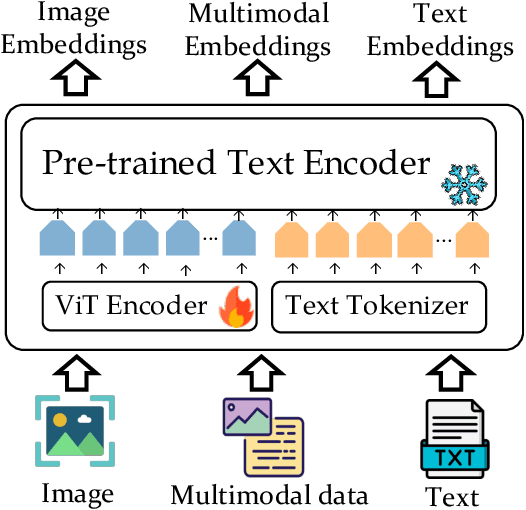
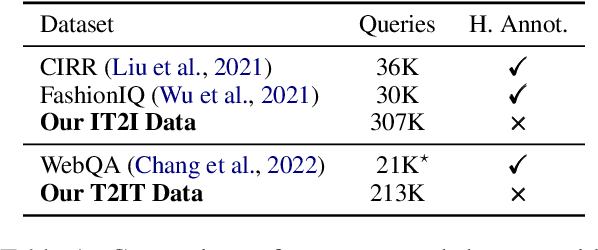
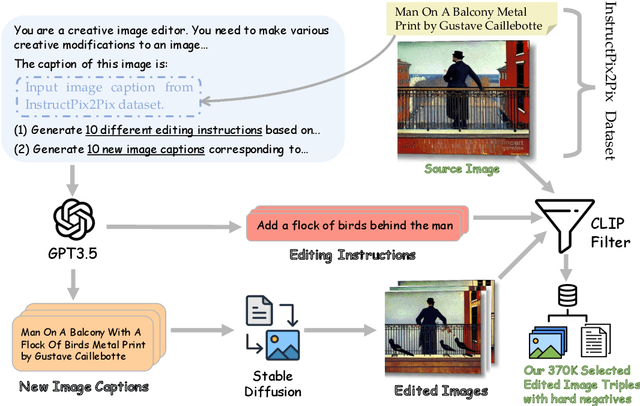

Abstract:Multi-modal retrieval becomes increasingly popular in practice. However, the existing retrievers are mostly text-oriented, which lack the capability to process visual information. Despite the presence of vision-language models like CLIP, the current methods are severely limited in representing the text-only and image-only data. In this work, we present a new embedding model VISTA for universal multi-modal retrieval. Our work brings forth threefold technical contributions. Firstly, we introduce a flexible architecture which extends a powerful text encoder with the image understanding capability by introducing visual token embeddings. Secondly, we develop two data generation strategies, which bring high-quality composed image-text to facilitate the training of the embedding model. Thirdly, we introduce a multi-stage training algorithm, which first aligns the visual token embedding with the text encoder using massive weakly labeled data, and then develops multi-modal representation capability using the generated composed image-text data. In our experiments, VISTA achieves superior performances across a variety of multi-modal retrieval tasks in both zero-shot and supervised settings. Our model, data, and source code are available at https://github.com/FlagOpen/FlagEmbedding.
 Add to Chrome
Add to Chrome Add to Firefox
Add to Firefox Add to Edge
Add to Edge